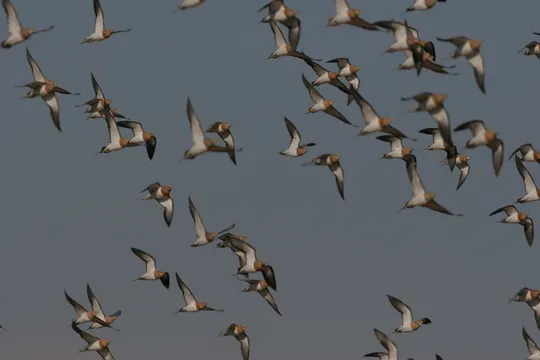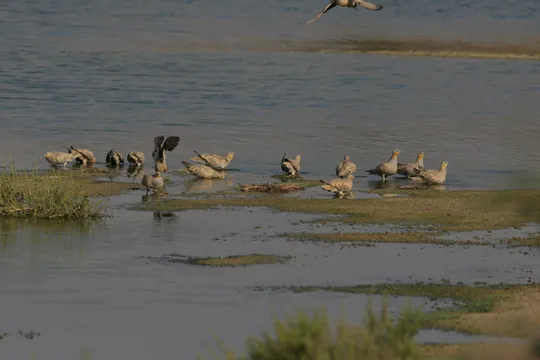Pterocles lichtensteinii
 Critically Endangered
Critically Endangered
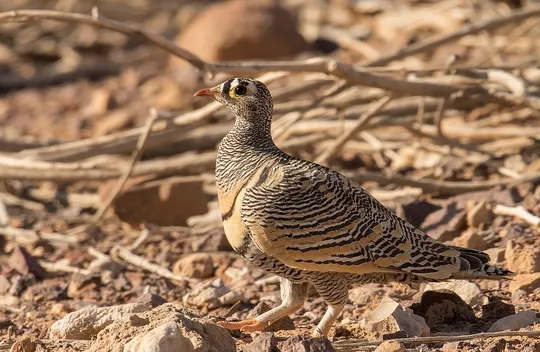
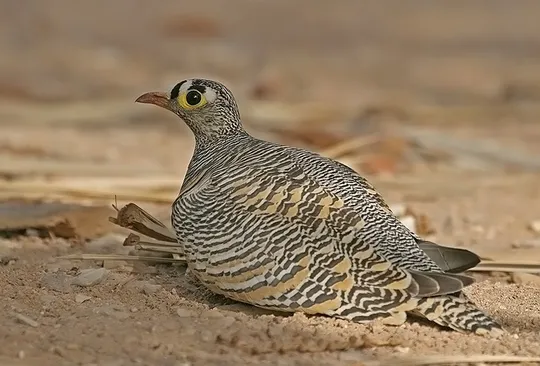
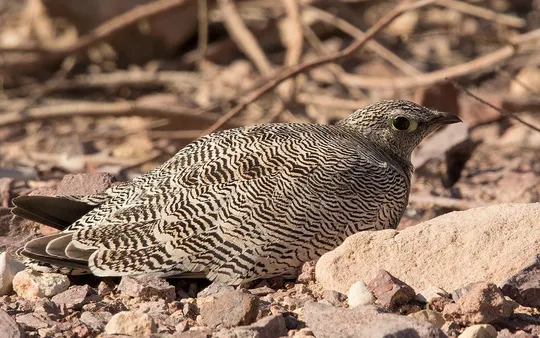
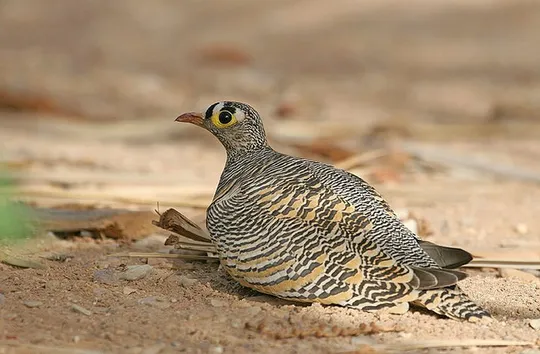
| Habitats | Desert Plains, Salt Marsh |
|---|---|
| Presence In Israel | Resident |
| Breeding In Israel | Breeder |
| Migration Types | Resident |
| Zoographical Zones | Sudani |
| Landscape Types | Plains & Valleys, Wide Wadis, Rural Area |
| Vegetation Densities | Low |
| Nest Locations | Ground |
| Diet Types | Herbivore |
| Foraging Grounds | Ground |
| Body Sizes | Small (up to 500g) |
| Threat Factors | Unknown, Tree planting, Habitat loss and fragmentation |
Lichtenstein's Sandgrouse is the smallest sandgrouse in Israel. Both sexes have a dark brown barred plumage, which gives them a generally dark appearance. The male has a patchy black-white pattern on its crown and forehead and a yellow eye-ring. It forms small flocks throughout the year and breeds in sparse scattered colonies. It gathers at regular drinking sites at dusk, unlike other sandgrouse in Israel that fly to drinking sites in the morning.
Lichtenstein's Sandgrouse is a resident species and rare breeder in the southern Arava, in the triangle between Eilat, Lotan and Neot Smadar.
Hill slopes, broad wadis with low vegetation and rocky desert flats in the extreme desert. Also nests at the edges of settlements and is dependent on water sources for drinking.
In the 1980s, the Lichtenstein's Sandgrouse population was estimated at about 50 to 100 pairs, based on visits to drinking sites (Shirihai 1996). During the past decade, the number of Lichtenstein's Sandgrouse decreased and the current population is estimated at less than 50 adults (Itai Shani and Noam Weiss, pers. comm.).
Lichtenstein's Sandgrouse is apparently affected by the accelerated development in the southern Arava in recent years, which modifies and disturbs its natural habitats, and by invasive and eruptive species, which apparently affect the breeding success of ground nesters in general, and of sandgrouse in particular.
No specific conservation measures have been taken for this species to date.
Lichtenstein's Sandgrouse is a resident species with an extremely restricted range in Israel, limited to the southern Arava. The Israeli population has always been small, but in recent years there has been a significant decrease in the number of observed birds, and the current population is estimated at less than 50 adult birds. There is a need for research to understand the factors behind this decrease.
The population should be monitored and studied to clarify the factors threatening it.
- פז, ע. 1986. עופות. מתוך אלון, ע. (עורך), החי והצומח של ארץ ישראל. כרך 6. הוצאת משרד הביטחון, ישראל.
- פרלמן, י., שוחט, א. ולבינגר, ז. 2009. סקר אטלס ציפורים בערבה סיכום שנת 2009. דו"ח מרכז הצפרות של החברה להגנת הטבע.
- Perlman, Y., Shochat, E. and Labinger, Z. 2011. Developing Managment plan for important bird areas in southern Israel. second annual report, Nizzana region and Arava Valley.Israeli Ornithological center, SPNI.
- Shirihai, H., 1996. The Birds of Israel. Academic Press, London.
- Symes, A. 2013. Species generation lengths. Unpublished, BirdLife International.
- Species page at Birdlife International
Current Occupancy Map
| Data Missing | Sporadic | Limited Sites | Low Density | High Density |
|---|---|---|---|---|
| 0 | 0 | 0 | 0 | 0 |
Distribution maps
The maps presented here provide visual information on the distribution of species in Israel from the past and present, and the changes in occupancy and breeding density during the comparison period. For further reading
Relative Abundance 2010-2020
Breeding density values in the current decade as determined from experts' opinion and observations from databases.
| Data Missing | Sporadic | Limited Sites | Low Density | High Density |
|---|---|---|---|---|
| 8 | 12 | 12 | 21 | 19 |
Relative Abundance 1980-1990
Density values based primarily on the book The Birds of Israel (Shirihai 1996).
| Data Missing | Sporadic | Limited Sites | Low Density | High Density |
|---|---|---|---|---|
| 5 | 14 | 14 | 17 | 22 |
Occupancy 1990-2020
The map shows differences in the species breeding distribution between the 1980's breeding map and the current weighted breeding evaluation. Negative value - species previously bred in the grid and is not presently breeding; positive value - species has not previously bred in the grid and is currently breeding.
| Data Missing | No Change | Occupancy Increase | Occupancy Decrease |
|---|---|---|---|
| 6 | 35 | 1 | 9 |
Change in Relative Abundance 1990-2020
The map shows the changes in the relative abundance of a species in each of the distribution grids between the breeding map of the 1980s and the weighted current breeding evaluation. Negative values - decline in abundance; positive values - increase in abundance; zero - no change in abundance.
| 80 to 100 | 50 | 20 to 30 | No Change | 30- to 20- | 50- | 100- to 80- | Data Missing |
|---|---|---|---|---|---|---|---|
| 0 | 4 | 2 | 22 | 12 | 14 | 11 | 16 |
| Rarity | |
|---|---|
| Vulnerability | |
| Attractiveness | |
| Endemism | |
| Red number | |
| Peripherality | |
| IUCN category | |
| Threat Definition according to the red book |
 Contributed:
Contributed: 